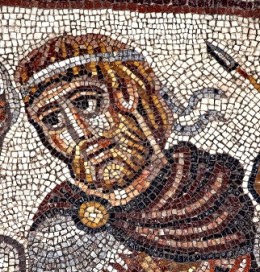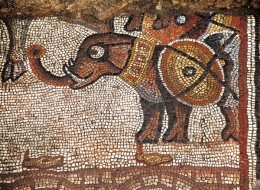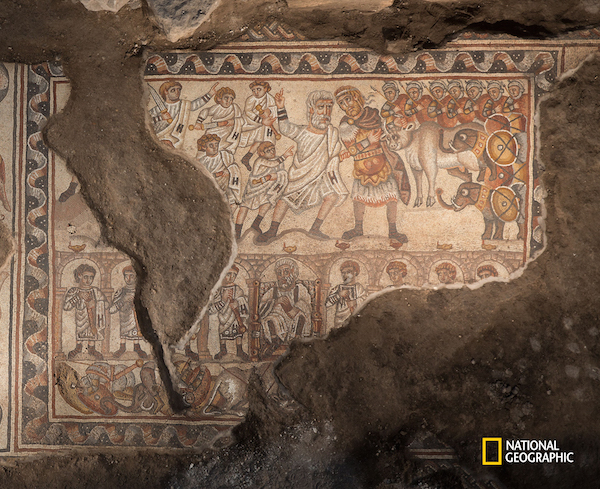This article which was written by Robin Ngo appeared in the online edition of Bible History Daily on 14 September 2016.

Does this military figure depict Alexander the Great meeting with the Jewish high priest? The full Huqoq mosaic from a Late Roman–Byzantine synagogue can be viewed below. Photo: Jim Haberman.
A 1,500-year-old mosaic that might depict a meeting between Alexander the Great and the Jewish high priest has been unveiled in full byNational Geographic. The mosaic was unearthed during excavations of a fifth-century C.E. synagogue at Huqoq, a site in Israel’s Lower Galilee. Led by Jodi Magness, the Kenan Distinguished Professor for Teaching Excellence in Early Judaism at the University of North Carolina at Chapel Hill, the Huqoq excavations have each year revealed vibrant mosaic floors depicting a variety of scenes, from the exploits of the Biblical hero Samson to the Exodus and Noah’s Ark.
The possible depiction of Alexander the Great at Huqoq was first reported in 2014. In a Bible History Daily guest post, Magness and mosaics specialist Karen Britt described the magnificent scene:
The bottom register shows a dying soldier grasping his shield as he falls and a bull pierced by spears, with blood gushing from his gaping wounds. In the middle register, the arches of an arcade frame a seated elderly man and the young men who flank him. Lighted oil lamps are shown above each arch. The top register … depicts an encounter between two large male figures. One figure is clearly intended to represent a military commander and ruler: He is bearded and has a diadem on his head, is outfitted in ornate battle dress, and wears a purple cloak (see accompanying photo). This figure leads a large bull by the horns, and he is accompanied by a row of soldiers arranged as a Greek phalanx and by battle elephants with decorated collars and shields tied to their sides. The commander/ruler is nodding to a bearded, elderly man wearing a ceremonial white tunic and mantle. The elderly man is escorted by young men holding sheathed swords or daggers who are also dressed in ceremonial white tunics and mantles.
Now, National Geographic has published the Huqoq mosaic in full:
Because the mosaic doesn’t label the figures, the scene is open for interpretation. According to National Geographic, Magness and Britt diverge on their opinions of what the Huqoq mosaic portrays.

This is one of two battle elephants who, along with a bull and a row of soldiers, accompanies what may be Alexander the Great. Photo: Jim Haberman.
Magness, National Geographic reports, believes the Huqoq mosaic, which should be read from the bottom up, portrays Macedonian king Alexander the Great’s fourth-century B.C.E. conquests in the eastern Mediterranean. The top portion of the mosaic, Magness argues, shows Alexander the Great in a purple cloak meeting Jerusalem’s high priest, who is wearing a white tunic. While this meeting did not actually occur in history, the legend appears in the writings of ancient Jewish historian Josephus and in rabbinic literature.
“After Alexander’s death in 323 B.C.E., when his fame spread and his importance became clear because of the way that he changed the face of the Near East, the Jews—like other ancient people—sought to associate themselves with him and his greatness,” Magness told National Geographic. “That’s why stories like this legend began to circulate.”
On the other hand, Karen Britt, along with history scholar and fellow Huqoq excavation member Ra’anan Boustan, believes the Huqoq mosaic portrays Seleucid king Antiochus VII’s attack on Jerusalem in 132 B.C.E. The top portion, Britt and Boustan say, represents a meeting to discuss a truce between Antiochus VII in the purple cloak and John Hyrcanus I, the Hasmonean leader and Jewish high priest, in the white tunic.
“The Jews were frequently conquered by other people,” Britt explained to National Geographic. “The message here is that not only could they hold their own in battle, but they could also reach an honorable and mutually agreeable treaty with their overseers.”
Explore the stunning Huqoq mosaic further in National Geographic.


